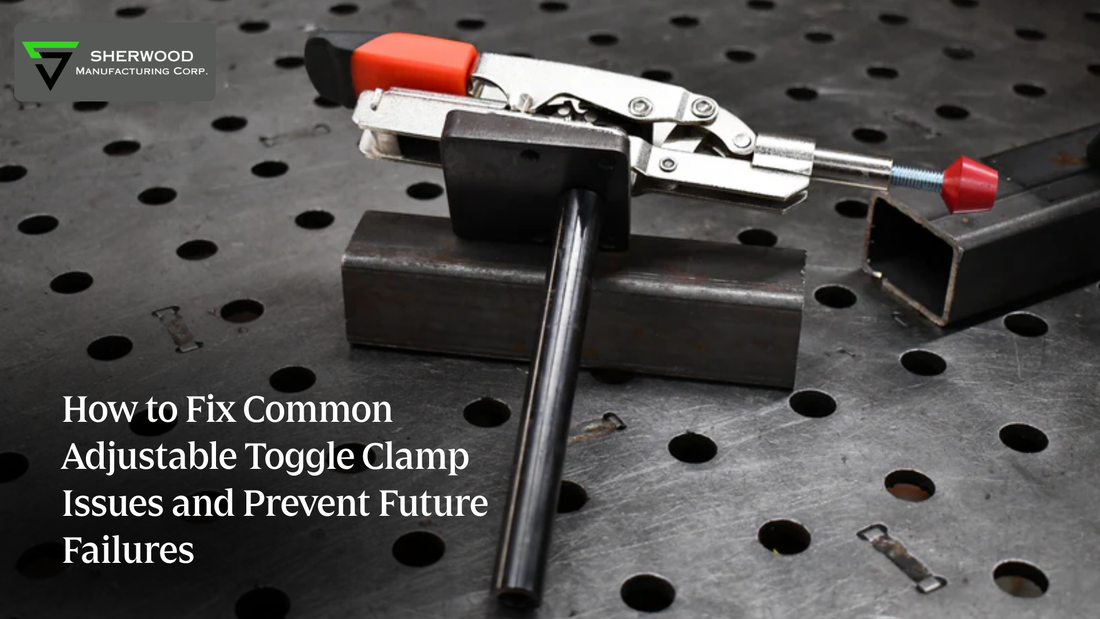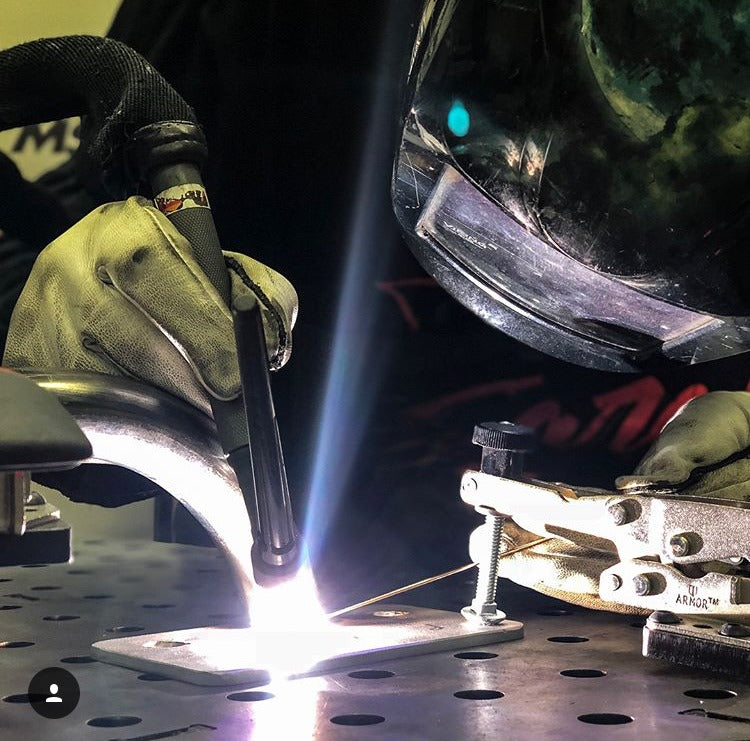
How to Fix Common Adjustable Toggle Clamp Issues and Prevent Future Failures
Share
Introduction
An adjustable toggle clamp is one of the most reliable tools in any workshop, ensuring your workpieces stay secure during cutting, welding, or assembly. But what happens when the clamp itself starts to fail? Suddenly, that smooth workflow can be replaced by frustration, poor accuracy, and even safety hazards.
The truth is toggle clamps and toggle latch clamps aren’t indestructible. Heavy use, lack of maintenance, or environmental factors can cause looseness, rust, jamming, or misalignment.
This guide walks you through the most common adjustable toggle clamp problems and exactly how to fix them. Plus, if you’re looking for long-lasting reliability in welding attachments and clamps, we’ll show you why many professionals prefer Sherwood Manufacturing for their toggle clamp needs.
Common Problems with Adjustable Toggle Clamps
Like all precision tools, toggle clamps are susceptible to wear and tear if not regularly maintained. Some of the most frequent issues include:
• Loose clamps – Loose clamps often occur when the springs lose tension over time, reducing their grip and stability. They can also result from misadjusted or poorly tightened bolts, which compromise the overall clamping force.
• Jammed latches – Jammed latches are commonly caused by the buildup of dust, grease, or fine metal shavings that obstruct smooth movement. Over time, this debris creates friction, preventing the latch from opening or closing properly.
• Rust or corrosion – Rust or corrosion develops when clamps are regularly exposed to moisture, humidity, or harsh environments. This weakens the metal surface, reducing both durability and clamping efficiency over time.
• Weak clamping force – Weak clamping force often results from worn-out or fatigued springs that can no longer provide enough tension. It may also be caused by improper alignment, preventing the clamp from applying uniform pressure.
• Bent handles or arms – Bent handles or arms typically occur when excessive force is applied beyond the clamp’s capacity. This deformation not only reduces efficiency but can also make the clamp difficult or unsafe to operate.
Most of these problems stem from heavy use in welding shops, woodworking, or assembly lines. By catching them early, you can avoid costly replacements and minimize downtime.
Why Does My Toggle Clamp Lose Tension?
One of the most common complaints is when the toggle clamp starts losing clamping force. This usually happens because:
• Springs can weaken over time as they undergo repeated stress cycles. This gradual fatigue reduces their tension, leading to a noticeable drop in clamping strength.
• Threaded rods may slip when they are not tightened properly during setup. This loosening affects stability and reduces the overall clamping force.
• Constant vibrations can gradually shift the clamp’s alignment out of position. This misalignment reduces accuracy and weakens the clamping efficiency over time.
The Quick Fix:
• Tighten the adjustment bolt on the clamp until resistance feels firm but not overly strained.
• Check the catch plate or fixture area to ensure alignment with the arm.
• If the spring is visibly worn out, replacement is the safest option.
Pro insight: Many professionals prefer leveraging Sherwood Manufacturing’s auto-adjusting toggle clamps because they automatically regulate the right pressure solving one of the most frustrating problems in everyday clamping.
Fixing a Jammed or Sticking Toggle Clamp

It’s common for clamps to jam or stick, especially in welding environments where dust, grit, and metal shavings accumulate.
Steps to Fix It:
• Clean out debris using a brush or compressed air.
• Apply a light lubricant to pivot points and joints.
• Check for bent handles or rods that may cause binding.
• If jamming persists, replace the spring or latch mechanism.
If you’re using clamps for repetitive fixturing, the STC-HH50-618-1.00-RK is a great choice. Designed with a mounting base for BuildPro tables, it’s built for long-term durability and smoother operation reducing the risks of sticking.
How to Prevent Rust and Corrosion in Adjustable Clamps
Rust is perhaps the worst enemy of toggle latch clamps. Once corrosion sets in, clamping performance drops dramatically.
Prevention Strategies:
• Choose stainless-steel clamps when working in high-humidity or outdoor environments.
• Apply a rust-preventive spray or oil after cleaning.
• Wipe and dry clamps after welding sessions, especially if exposed to cooling fluids.
• For industrial use, apply protective coatings to ensure longer service life.
This is where Sherwood’s auto-adjusting clamps stand out engineered for heavy-duty use with optional stainless finishes that resist corrosion, extending clamp longevity significantly.
Adjusting an Adjustable Toggle Clamp the Right Way
Improper adjustment is another root cause of clamp inefficiency.
• Locate the threaded adjustment bolt on the clamp’s arm.
• Turn clockwise to increase pressure, or counterclockwise to reduce strain.
• Test clamping on scrap pieces before locking into regular use.
• Ensure that the arm and catch plate align properly, not just tightly. Misalignment causes uneven wear.
For example, the STC-HH50-618-5.75-RK comes with a 5-3/4 inch stand and a rubber-ended bolt, giving you better reach and control for taller assemblies helping eliminate adjustment headaches on BuildPro tables.
Repair or Replace: Choosing the Best Option

When faced with clamp failure, the question is always: Should you repair or replace?
• Repair: For minor problems like dirt buildup, looseness, or minor misalignment, repair is quick and
cost-effective.
• Replace: If clamps show cracks, major rust, or spring fatigue, replacement is safer and more reliable.
Professionals who seek long-term reliability often turn to Sherwood Manufacturing. Their precision-engineered toggle clamps like the STC-HH50-618-5.75-LF equipped with a steel finger contact point are built for durability in demanding welding environments.
By choosing the right replacement, you save long-term cost, increase efficiency, and improve workplace safety.
FAQs (People Also Ask Format)
Q1: What causes an adjustable toggle clamp to fail?
Clamps fail due to wear, misalignment, rust, weak springs, or overexertion of force.
Q2: Can toggle clamps be adjusted easily?
Yes. Simply turn the threaded screw or rod to fine-tune clamping pressure. Auto-adjusting clamps make this process seamless.
Q3: How do you maintain a toggle latch or clamp?
Clean regularly, apply lubrication, check bolts for tightness, and use anti-rust products for metal clamps.
Q4: Are toggle clamps and toggle latches the same?
Both work on similar principles. A toggle clamp holds workpieces in welding or woodworking, while a toggle latch secures panels, doors, or enclosures.
For a full range of long-lasting solutions, explore Sherwood’s adjustable toggle clamps collection designed for BuildPro tables and welding applications.
Conclusion
An adjustable toggle clamp is only as effective as the care and attention it receives. From tension loss and jammed movements to rust and alignment issues, nearly every problem has a quick fix if identified early.
However, if your clamps are consistently failing, upgrading to precision-built solutions is the smartest step. That’s why Sherwood Manufacturing is the go-to source for professionals looking for durable, high-quality toggle clamps, latches, and welding attachments.
By understanding these common issues and knowing how to fix them you’ll not only extend the life of your clamps but ensure your welding projects and assemblies remain precise, safe, and efficient.

